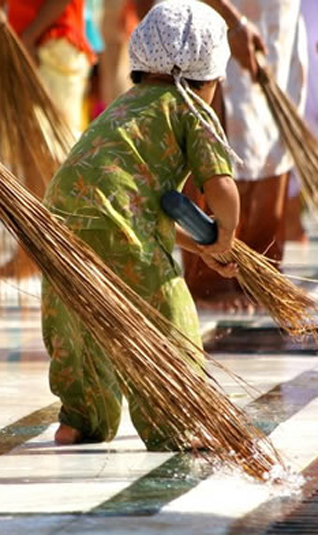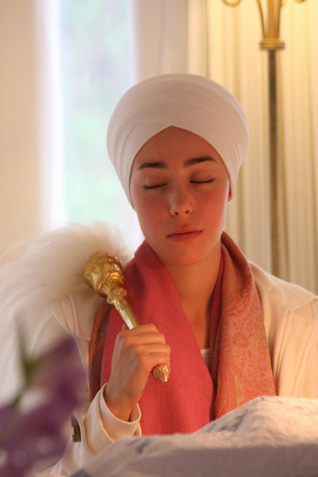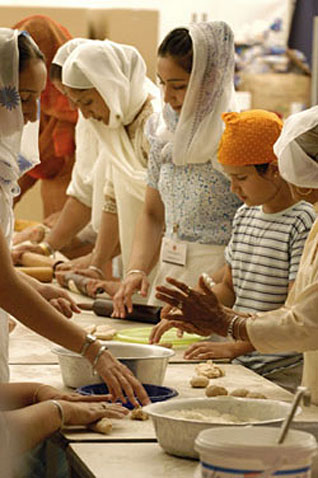Roundtable
Which Is More Important In Sikhi: Faith or Works?
The Roundtable Open Forum # 88
by BALPREET SINGH
For Sikhs, faith and works are connected, like a tree and its fruit.
If I truly have faith in a set of beliefs, then my life and actions will reflect them. Faith must translate into action, or it cannot be said to truly exist in the first place.
One of Guru Nanak's first teachings was that labels don't matter. One can be called a Sikh, Muslim or Christian, but what matters is the content of one's character.
I can profess to be a Sikh but if my actions do not reflect the virtues and beliefs of the Sikh faith, then the label is really just an indulgence of my ego. Guru Gobind Singh, the Tenth Master, said, "one cannot call one's self a Sikh without the conduct."
To give beliefs a practical form, Sikhs observe the "Rehat Maryada" or the Sikh code of conduct. The Rehat explains how a Sikh's daily lifestyle can embody the principles of the faith.
As a part of observing Rehat, Sikhs wear five articles of faith, such as the kesh (unshorn hair, which is kept covered with a turban) and the kirpan. The articles remind us that our beliefs must be reflected in our daily lives. Each article represents a core Sikh belief and is also a public and very visible commitment to living those beliefs on a daily basis.
The Rehat also stresses the importance of the dual concepts of simran (meditation) and seva (selfless service). We meditate in order to become closer to God but the true measure of our spiritual progression is whether our daily life reflects divine virtues such as compassion, truth and equality.
These virtues take a practical form through seva and our service to humanity.
So in short, Sikhs believe that one who talks the talk, must also walk the walk.
[Courtesy: Ottawa Citizen]
March 9, 2012
Conversation about this article
1: Sangat Singh (Kuala Lumpur, Malaysia), March 09, 2012, 9:58 AM.
The institution of seva is an important and integral part of the Sikh religion, as is for most other religious groups in various forms. However there is a proviso. Selfless seva with humility alone is not enough. The humility itself becomes an ego that goes imperceptibly deeper and becomes a 'dhirag rog' and most difficult to eradicate. There are hundreds of such stories but let me take just one example: During Guru Arjan's time, there was a powerful and wealthy village leader by the name of Teerath, better known as Bhai Manjh. He was an ardent follower of a Muslim deviant 'Sakhi Sarvar' sect. Once passing through Amritsar, he decided to visit Guru Arjan who was known to be spiritually enlightened. Just this brief encounter was enough to show him the real path. He decided to abandon his position as the headman and renouncing his considerable wealth, he plunged into the seva of bringing firewood for the langar, cleaning dishes and serving the sangat in every way possible, all the while repeating the naam. Apparently this alone was not enough in the eyes of the Guru. He was summoned one day. The Guru asked: "Bhai Manjh, where do you eat?" "Satguru, I partake in your langar." Guru Arjan said: "Well then, you are then nothing more than a wage-labourer, aren't you?" Bhai Manjh had sacrificed his position and entire wealth to do seva. Apparently this was not enough in the eyes of the Guru, as some ingredient was missing. Was it, perhaps: 'ghaal khaa-ay kichh hathahu day-ay/ Nanak raahu pachhannah say' [GGS:124.5] - "One who works for what he eats and shares some of what he has, O Nanak, he knows the path!" Naam Juppna, kirat karni and vund chhukna? - "Meditate on His name, earn an honest living, and share with others." This was the standard set by the Gurus for seva. Bhai Manjh now decided to no longer eat in the langar. He decided to collect two bundles of wood, one for langar and the other he would sell to earn his living. He found the real wealth and treasure of naam that no thief could steal nor any king seize. Culmination of the seva was when one day he fell into a well during a sandstorm. When Guru Arjan heard about it, he ran bare-footed, together with a band of Sikhs, and threw a rope and asked Manjh to pull himself out. Bhai Manjh insisted that the wood that had also fallen in with him was to be first removed lest it should get wet and be of no use in the langar. Guru Arjan was so pleased and said: "Bhai Manjh, your seva has borne fruit. Ask anything you want!" Bhai Manjh's response was that he wanted the Guru to bless him that he should be free from wants and remain always content and at His feet. Bhai Manjh was honoured by the Guru with the words: 'Manjh is the beloved of the Guru, and Guru is the beloved of Manjh. Manjh is the ferry of the Guru who will ferry across the bhaujal of the world's ocean.' I apologize for this longish response.
2: Barinder Singh Basan (Bangalore, India), March 09, 2012, 9:59 AM.
In Sikhi, rehat and seva are inseparable. Rehat is personal ... a personal medium of dialogue between a Sikh and his Guru. Seva is rehat in action ... "jeh seva nahi keeti ... rehat vi na kar sako-gey ...
3: Baldev Singh (Bradford, United Kingdom), March 09, 2012, 10:23 AM.
Seva is critical, along with kirat, naam and Vund chhakna, and all are symbiotically intertwined with each other, to the point that they can't exist as separate entities in the practice of Sikhi.
4: Baldev Singh (Bradford, United Kingdom), March 09, 2012, 11:36 AM.
I must mention that the three photos on this page are worth a billion words! The one of the child doing seva is just adorable, the beautiful Kaur doing simran is pure female power! And the classy Kaurs and young Singh making rotis for langar is cool!
5: Ravinder Singh (Mumbai, India), March 10, 2012, 3:03 AM.
Sikhi tells us to lead our life according to Waheguru's hukam by abiding in naam and doing seva for our fellow human beings. These are the means to achieve the goal of our human birth, which is self realization.They enable us to conquer our ego and live life according to Waheguru's hukam. But at the same time we should also be doing introspection as to whether we are taking Waheguru's name and doing seva merely to feed our ego.
6: Gurjender Singh (Maryland, U.S.A.), March 10, 2012, 2:28 PM.
One of the elements missing in the discussion is the role of truth in daily life - in both faith and works-related activities.
7: Ajit Singh Batra (Pennsville, New Jersey, U.S.A..), March 10, 2012, 10:43 PM.
Gurjender ji (item#6): It is the love of God that is the basis of seva. Truth prevails automatically when seva is selfless and flowing naturally in a truly God-conscious person. Worship and service of God then become the love and service of mankind. God is present in the innermost being of all.





